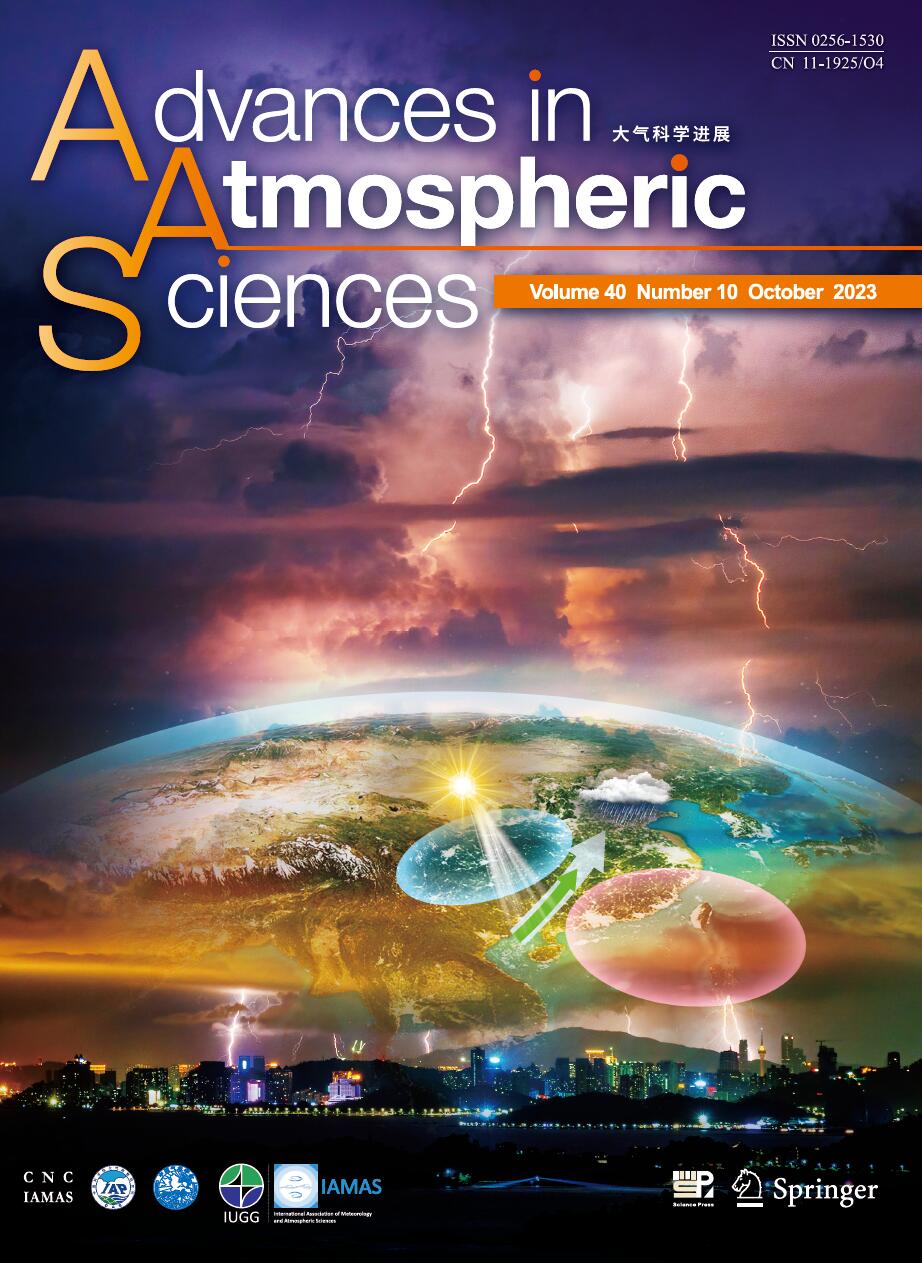| [1] |
ZHANG Lixia* and ZHOU Tianjun, ,
2014: An Assessment of Improvements in Global Monsoon Precipitation Simulation in FGOALS-s2, ADVANCES IN ATMOSPHERIC SCIENCES, 31, 165-178.
doi: 10.1007/s00376-013-2164-6
|
| [2] |
ZOU Liwei, ZHOU Tianjun,
2015: Asian Summer Monsoon Onset in Simulations and CMIP5 Projections Using Four Chinese Climate Models, ADVANCES IN ATMOSPHERIC SCIENCES, 32, 794-806.
doi: 10.1007/s00376-014-4053-z
|
| [3] |
Song YANG, WEN Min, Rongqian YANG, Wayne HIGGINS, ZHANG Renhe,
2011: Impacts of Land Process on the Onset and Evolution of Asian Summer Monsoon in the NCEP Climate Forecast System, ADVANCES IN ATMOSPHERIC SCIENCES, 28, 1301-1317.
doi: 10.1007/s00376-011-0167-8
|
| [4] |
BUHE Cholaw, Ulrich CUBASCH, LIN Yonghui, JI Liren,
2003: The Change of North China Climate in Transient Simulations Using the IPCC SRES A2 and B2 Scenarios with a Coupled Atmosphere-Ocean General Circulation Model, ADVANCES IN ATMOSPHERIC SCIENCES, 20, 755-766.
doi: 10.1007/BF02915400
|
| [5] |
REN Guoyu, DING Yihui, ZHAO Zongci, ZHENG Jingyun, WU Tongwen, TANG Guoli, XU Ying,
2012: Recent Progress in Studies of Climate Change in China, ADVANCES IN ATMOSPHERIC SCIENCES, 29, 958-977.
doi: 10.1007/s00376-012-1200-2
|
| [6] |
Jeong-Hyeong LEE, Byungsoo KIM, Keon-Tae SOHN, Won-Tae KOWN, Seung-Ki MIN,
2005: Climate Change Signal Analysis for Northeast Asian Surface Temperature, ADVANCES IN ATMOSPHERIC SCIENCES, 22, 159-171.
doi: 10.1007/BF02918506
|
| [7] |
JIANG Dabang,
2008: Projected Potential Vegetation Change in China under the SRES A2 and B2 Scenarios, ADVANCES IN ATMOSPHERIC SCIENCES, 25, 126-138.
doi: 10.1007/s00376-008-0126-1
|
| [8] |
FU Yuanhai, LU Riyu,
2010: Simulated Change in the Interannual Variability of South Asian Summer Monsoon in the 21st Century, ADVANCES IN ATMOSPHERIC SCIENCES, 27, 992-1002.
doi: 10.1007/s00376-009-9124-1
|
| [9] |
Li Chongyin, Mu Mingquan,
2001: The Influence of the Indian Ocean Dipole on Atmospheric Circulation and Climate, ADVANCES IN ATMOSPHERIC SCIENCES, 18, 831-843.
|
| [10] |
HAN Zuoqiang, YAN Zhongwei*, LI Zhen, LIU Weidong, and WANG Yingchun,
2014: Impact of Urbanization on Low-Temperature Precipitation in Beijing during 19602008, ADVANCES IN ATMOSPHERIC SCIENCES, 31, 48-56.
doi: 10.1007/s00376-013-2211-3
|
| [11] |
ZHU Yali,
2012: Variations of the Summer Somali and Australia Cross-Equatorial Flows and the Implications for the Asian Summer Monsoon, ADVANCES IN ATMOSPHERIC SCIENCES, 29, 509-518.
doi: 10.1007/s00376-011-1120-6
|
| [12] |
Bueh Cholaw, Ji Liren, Sun Shuqing, Cui Maochang,
2001: EAWM-Related Air-Sea-Land Interaction and the Asian Summer Monsoon Circulation, ADVANCES IN ATMOSPHERIC SCIENCES, 18, 659-673.
|
| [13] |
YAN Renchang, BIAN Jianchun,
2015: Tracing the Boundary Layer Sources of Carbon Monoxide in the Asian Summer Monsoon Anticyclone Using WRF-Chem, ADVANCES IN ATMOSPHERIC SCIENCES, 32, 943-951.
doi: 10.1007/s00376-014-4130-3
|
| [14] |
LIU Xiangwen, WU Tongwen, YANG Song, JIE Weihua, NIE Suping, LI Qiaoping, CHENG Yanjie, LIANG Xiaoyun,
2015: Performance of the Seasonal Forecasting of the Asian Summer Monsoon by BCC_CSM1.1(m), ADVANCES IN ATMOSPHERIC SCIENCES, 32, 1156-1172.
doi: 10.1007/s00376-015-4194-8
|
| [15] |
BIAN Jianchun, YAN Renchang, CHEN Hongbin, Lu Daren, Steven T. MASSIE,
2011: Formation of the Summertime Ozone Valley over the Tibetan Plateau: The Asian Summer Monsoon and Air Column Variations, ADVANCES IN ATMOSPHERIC SCIENCES, 28, 1318-1325.
doi: 10.1007/s00376-011-0174-9
|
| [16] |
Lu Peisheng,
1995: Evolution of Asian Summer Monsoon and the Slowly Varying Disturbances, ADVANCES IN ATMOSPHERIC SCIENCES, 12, 311-318.
doi: 10.1007/BF02656979
|
| [17] |
Yiran GUO, Jie CAO, Hui LI, Jian WANG, Yuchao DING,
2016: Simulation of the Interface between the Indian Summer Monsoon and the East Asian Summer Monsoon: Intercomparison between MPI-ESM and ECHAM5/MPI-OM, ADVANCES IN ATMOSPHERIC SCIENCES, 33, 294-308.
doi: 10.1007/s00376-015-5073-z
|
| [18] |
LU Riyu, Buwen DONG,
2008: Response of the Asian Summer Monsoon to Weakening of Atlantic Thermohaline Circulation, ADVANCES IN ATMOSPHERIC SCIENCES, 25, 723-736.
doi: 10.1007/s00376-008-0723-z
|
| [19] |
CHEN Bin, XU Xiang-De, YANG Shuai, ZHANG Wei,
2012: On the Temporal and Spatial Structure of Troposphere-to- Stratosphere Transport in the Lowermost Stratosphere over the Asian Monsoon Region during Boreal Summer, ADVANCES IN ATMOSPHERIC SCIENCES, 29, 1305-1317.
doi: 10.1007/s00376-012-1171-3
|
| [20] |
WU Bingyi, WANG Dongxiao, HUANG Ronghui,
2003: Relationship between Sea Level Pressures of the Winter Tropical Western Pacific and the Subsequent Asian Summer Monsoon, ADVANCES IN ATMOSPHERIC SCIENCES, 20, 496-510.
doi: 10.1007/BF02915494
|















 AAS Website
AAS Website 
 AAS WeChat
AAS WeChat 
 DownLoad:
DownLoad: